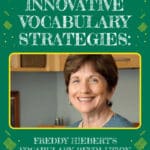
“Research shows that vocabulary is the best support for students' comprehension of narrative and information texts. Often, vocabulary instruction focuses on a few target words in specific texts. However, to understand the many new words in complex texts students need to know how words work.” – Dr. Elfrieda Hiebert (Teaching Words and How They Work).
One of the biggest gaps that we experience as educators with our students (besides access to money) is access to words, their meanings, and how they're connected.
To explore this further (and uncover innovative vocabulary strategies we can use with our students), I invited the incredible Dr. Elfrieda Hiebert to join me for a conversation all about innovative vocabulary strategies that more people need to know about.
Elfrieda “Freddy” Hiebert (Ph.D., University of Wisconsin), has discovered a much faster and effective way to bridge the gap so that the folks that are highly resourced and the folks that are less resourced, may both grow greatly in their vocabulary knowledge.
So, if you’re concerned about vocabulary, and you're feeling a little overwhelmed, here’s the ‘light at the end of the tunnel’ revelation you’ve been waiting for…
Vocabulary Strategies: Small Changes for BIG Vocabulary Results
[If you'd rather read the transcript from the above video on vocabulary strategies, here ya go...]
Meet Dr. Elfrieda Hiebert
I have followed Dr. Elfrieda Hiebert (Freddy) since I started my doctoral studies, so you can imagine how excited I was to have her join me for an in-depth discussion about a topic we’re both so passionate about – vocabulary strategies!
But before we get into that, let’s take some time to get to know Freddy better.
Freddy is a prolific reading researcher and literacy leader. She’s had a huge influence on the development of my thinking here at Reading Simplified. When she was just six years-old, 😉 she helped co-write Becoming a Nation of Readers, which is probably one of the most influential documents in reading research from the 80's.
Freddy is also the President and CEO of TextProject, which has an amazing wealth of resources. She has taken her ideas and research, and successfully made them more palatable and understandable for those of us who don't have time to get into all of the nuances of research, while also providing us with plenty of resources for our classrooms.
Freddy is also the author of Teaching Words and How They Work: Small Changes for Big Vocabulary Results. I adore this book and highly recommend it, especially if you want to streamline things like we do here at Reading Simplified.
Introducing The Vocabulary Revolution
One of the lead messages that Freddy voices within the reading community is that we have new research ideas, and new information coming out that may change what we do in practice.
During my conversation with Freddy about ‘the vocabulary revolution’, she talked about how English is different than other languages like Spanish or French. We have a lot more words because English has different historical roots. It started as a German language and then we added some French to it, then some Latin-based words, and Greek words that provide the technical aspect.
There are around 600,000 words in English in the Oxford Dictionary, which leads to the question - which of those words should you teach? And, what should you be expecting from the words you teach?
TextProject has scanned around 10,000 student texts. Freddy then uses an analyzer that lets her look at 15 characteristics of each word in a text. From there, she can determine the words that appear a lot in a book.
Here’s an example of Freddy’s findings when searching for common and unique words in the book, Me and Uncle Romie by Claire Hartfield and Jerome Lagarrigue.

This book is used a lot in third-grade programs. The word cloud shows all the unique words in the book. Names like Nanette and Uncle Romie appear a lot in the book. However, there are a lot of unique words too.
There are around 601 unique words in a book of about 1700 words. Out of those 601 unique words, 11% are rare and for every 100 words, there are eight rare words.
So, which ones are you going to teach?
Teaching Kids That Words Represent Concepts

In the table above, you’ll see two different core reading programs. Both had the same text at grade three and both have a range of words. The thing about words is that they represent concepts.
So, what we haven't been teaching here, in part, are some of the underlying ideas about the content of the text. Knowledge is all about words, right? Yet, we haven't been helping kids understand how words work.
Some of these words, such as "cardboard," or "yanked" are pretty easy to figure out. You probably don't need a half-hour or 15-minute lesson on the word "yanked." So, this new work that lets us look at the distribution of words in thousands of texts, in a nanosecond, can get you the information on all the words in a book like this. We can now start clustering words together, words that fit together in terms of meaning.
Let’s take the same book, Me and Uncle Romie, and think about what kids could learn from this book.

So, it turns out this particular author uses an incredible number of compound words in a story. Compound words that have to do with the context in the things that the boy in the story, James, is seeing when he comes to New York City to visit his aunt and uncle.
As a result of computers, we know more about words. As Freddy stated during our discussion:
“I can tell you which of these words are actually predicted to have been in kids' oral language by the point they see it in text. I can tell you about which words rich, morphological families and we can start clustering words, according to different ideas of things that happen in books.”
Proper nouns are really prominent in books. In TextProject’s last study of the rare words in books, they found that around 30% of the rare words are proper nouns. So, we could actually be teaching kids about what some of the features of the city are. That's important, right?
One of the big findings in research is that what you know about a topic influences how well you comprehend. So, rather than teaching random words and random topics, we need to build bodies of knowledge.
We have to teach kids to learn things from texts!
Exploring Word Families
In Freddy’s book, Teaching Words and How They Work, she talks about the most important word families to teach and how to select the right words to teach from new information texts. So, I wanted to dig into this a little further, which is why I asked Freddy to talk about her work with word families.
Here’s what she had to say about word families:
“Words are a network that we call word families. For example, "glorious" is part of a word family with "glory” …. words are in conceptual groups. They're in morphological groups where there's some part of a meaning unit.”
We also dug deeper into Freddy’s research on vocabulary strategies and she revealed how she scanned many texts and asked - what vocabulary accounts for the majority of the words in those books?
It turns out that there are 2,500 word families and the word families aren't any surprise early on. A lot of the words that are in the 2,500 words families are words that have multiple meanings. They serve different functions. An example is the word family related to "concern," "concerning," "concerned," which is another example of what you'd seen in the morphological family.
“I don't think that there's one single way to teach vocabulary, but there is a stance toward teaching. What I'm saying is that you don’t need a word list perspective, but a word network perspective and the networks can be morphological families.”
We need to teach kids about those systems of morphology and semantic networks. Vocabulary that's unique to a text will help kids understand what the text is about.
How Can You Incorporate Different Vocabulary Strategies?
There are different ways that you can help kids understand that words represent concepts. One way is to use a certain structure, like compound words, or you could do it the context of places, such as what makes unique contexts of a city, (skyscrapers, the subway station, etc.). The point here is to give kids not just the single word and make sure that you've connected the bodies of knowledge that the words represent.
What is it that the child is learning? What does the vocabulary represent? So, instead of just choosing random individual words, understand that there are certain dimensions of a city that are important, or there are certain dimensions of a historical event that I want to learn about in a story, and so on.
You also need to think about things like how people communicate in stories. So, if a writer tells you that they're planning something rather than scheming, they are two completely different things. A good writer of a narrative doesn't keep repeating the same word over and over again. You know, you don't just go run, run, run, and say, run, over and over again.
You switch it up and use other words for ‘run’ such as chasing, galloping, etc. We want to teach kids how these words are connected.
Small Changes For BIG Vocabulary Results
So, what are some small changes a teacher (like you and I) can make to help achieve BIG vocabulary results for a student at a fourth or fifth-grade reading level?
Freddy’s first tip is to ensure kids do a significant amount of reading. If there are 2,500 families and their family members, each of these families has about five or six members on average. It’s not about getting all these words exactly right. What you're doing is ensuring that you're exposing kids to knowledge connections.
So if you take some books on seeds and plants, you’re going to keep seeing some words about seeds and plants, maybe a cone or, ‘dirt’ You want to ensure that there's some repetition of ideas and that you've actually stored those ideas somewhere.
“So I talk a lot in the book about word collections and I want to emphasize that these aren't just random words I'm putting up there, but I'm helping kids….there are many different ways in which I might say these words are related to each other, but what I want to do is ensure that kids are cognizant of what they've been learning.”
Around 90% to 95% of the words that kids see in texts keep appearing over and over again. That's the 2,500 families on the Common Core analysis. So when your student gets to a new text, whether they’re reading it independently or whether they’re doing it as part of an assessment, they need to be prepared to see around three to four words that they probably haven't seen before. It's likely that these words will be connected to each other. But if you do a lot of reading in class, that means that your students have had a lot of experience becoming flexible with the meanings of all these words that keep appearing.
They’ll be able to, (with great decoding ability that you helped them develop thanks to Reading Simplified), figure out the new words in the context of texts. So, just because it's a new word doesn't mean your students can't figure it out.
You can never teach your students all of the words they need to know. But you can make sure that they know how to figure out the words they don’t know on their own.
If you start that conversation at the beginning of the year, and you weave it through all the read aloud and all the science lessons and all the social studies lessons, etc., it will become part of their strategic approach to learning words.
A Sneak Peek at some Resources provided by Text Project
Another tip that Freddy shared is to do as much clustering as you can of the books that you have, because it turns out leveled books have an incredible amount of variation. You can even go across levels and feel okay about it, but it's the topic that's usually the most important, especially when it comes to tests and assessments.
Below is an example of a resource provided by TextProject. It shows an example of some of the words related to transportation (and yes, they always show the syllable because sometimes it can be difficult encountering words with different syllables).

This particular resource explores transportation in depth. Think about all the books that you have read on the subject of transportation – this theme can expand into other subjects too. You can also focus on some rhyming words using resources like this and word collections.
This idea of helping kids recognize what they know and how things fit together is what vocabulary is about.
TextProject has also gathered the 20 most prolific words in stories relating to how people communicate, traits, emotions, movements, and so on. This research showed that you can go a long way with mad, bag, glad, and sad. These are words that they all know, and then they become the source for expanding the semantic network.
A few key takeaways…
Freddy shared so much about innovative vocabulary strategies, core reading, and so much more. But, what is the one key takeaway that Freddy wants you to take from all of this? Well, here it is:
“I'd like for you to think about words as belonging to a knowledge basis. Texts are about knowledge and how we express knowledge is through words. The reason we want to expand kids’ vocabulary is that we want them to learn more things, but we also need to make sure they understand that words need to be connected.”
If you want to learn more about TextProject and get your hands on some of their amazing resources, visit: textproject.org
If you want to help improve your student’s reading ability using the innovative strategies we teach here at Reading Simplified, head over to readingsimplified.com/Academy to explore the training we offer to help you learn the system and streamline reader’s achievement.
What has been your key takeaway from my discussion with Freddy on vocabulary strategies? Let me know in the comments!





This is just what I have been looking for a better way to teach vocabulary. This will go right along with the narrow reading we will do this year.
May it serve your readers well, Laura! 🙂
I need more innovative ways to teach vocabulary
Audrey, her book is really good. We will also have more articles about vocab come out in July.
We need to so much more in this area of reading. Phonics and Phonemic awareness get a lot of time but a lot of teachers are not doing a lot of specific teaching for vocabulary.
Agreed! We’re going to have a full series on vocab instruction coming out in July so check back here.
AND, we had previous articles last year that can be found by searching “vocabulary” in our search bar. Thanks for your thoughts Melisa!
Fabulous resource, thank-you. This just reminds me of how important reading, thinking and writing are in developing comprehension & vocabulary. Do you think the character should have done what he did, was that a good idea & why, what were the consequences of those actions in the story and how would the story change if she had made a diffent choice? Making connections to other ideas through our discussions to foster critical thinking and improve vocabulary.
Exactly!! Glad it served you.